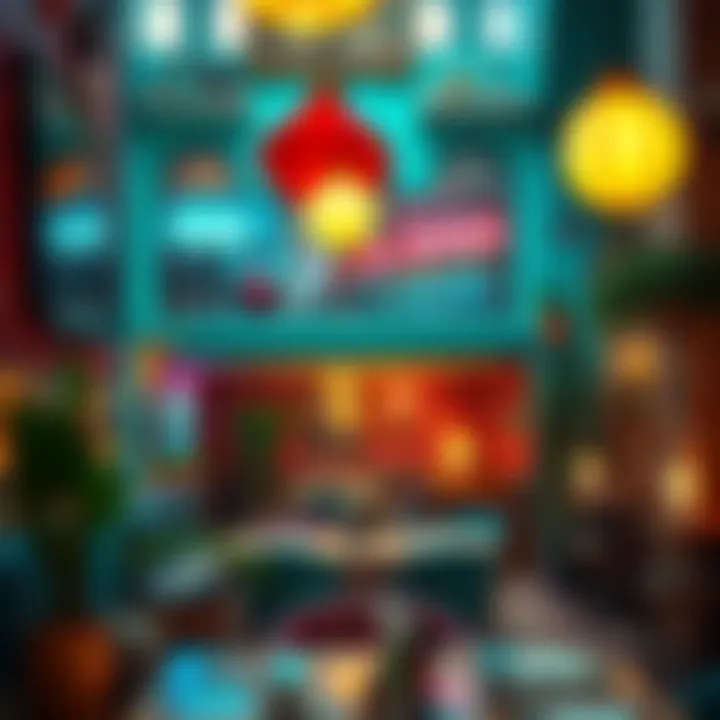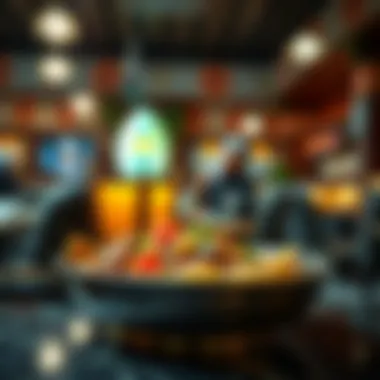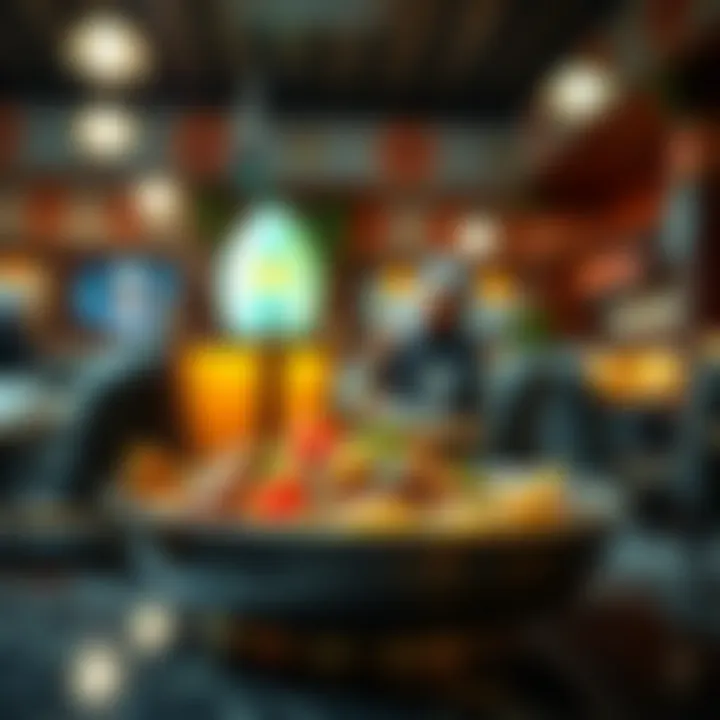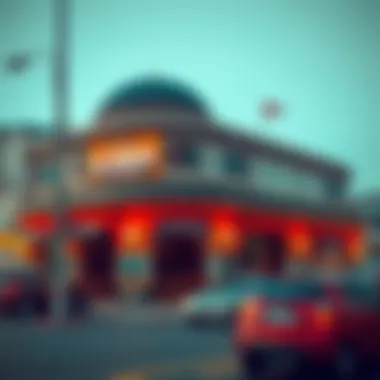Exploring the Cultural Essence of Al Marsa Cafeteria


Intro
Photographs have a way of capturing the essence of a location, revealing layers of meaning often overlooked in everyday life. In this exploration of Al Marsa Cafeteria, we will use photography not only as a means to document but also to interpret its cultural significance in Dubai. By immersing ourselves in the visuals, we will get a feel for the ambiance this cafeteria embodies and its pivotal role in the community it serves. From vibrant gatherings of friends and families to the tranquility of solitary moments while sipping a cup of fragrant cardamom coffee, each image tells a story.
Neighborhood Features
Al Marsa Cafeteria is nestled amidst a blend of contemporary and traditional landscapes that typify Dubai's ever-evolving architecture. This section delves into the unique aspects of the surrounding neighborhood, showcasing how these features contribute to the cafeteria's identity.
Landscaping Highlights
The greenery around Al Marsa is something to behold. Several palm trees sway gently in the warm Mediterranean breeze, providing a shady spot for those wanting to enjoy their meals outdoors. These touches of nature contrast sharply with the sleek, glass facades of buildings that tower nearby.
- Lush gardens are scattered here and there, beckoning passersby to take a moment to pause.
- Public art installations adorn the vicinity, making it a blend of nature and creativity.
Through the lens, photographers can capture not just the cafeteria but the harmonious interplay between this vibrant green environment and urban space.
Architectural Styles
The architectural fabric of the neighborhood mirrors Dubai's rich history while embracing modern design principles. Al Marsa Cafeteria itself showcases a blend of traditional motifs with contemporary decor, highlighted by:
- Arched windows that evoke historical Arabian style.
- Colorful tiles reminiscent of local craftsmanship, adding to the aesthetic appeal.
Photographers will find ample opportunities to juxtapose the cafeteria's inviting facade against the backdrop of towering skyscrapers or the idyllic backdrop of the Arabian Gulf, creating striking visual narratives.
Community Life
Every community has its heartbeat, and Al Marsa Cafeteria certainly serves as one of the key pulses in its neighborhood. This section uncovers the social dynamics that evolve around the cafeteria, enabling a richer narrative through photography.
Local Events and Activities
Throughout the year, the cafeteria is alive with various local events that reflect the rich tapestry of Dubai’s cultural landscape. From informal gatherings to community celebrations, photographers can witness
- Festivals that celebrate local cuisine, drawing crowds hungry for both food and fellowship.
- Weekly markets and fairs held nearby, fostering a spirit of togetherness.
Capturing these moments fosters a sense of connection, bringing forth the community's vibrancy.
Lifestyle Amenities
The area surrounding Al Marsa offers plenty of lifestyle amenities that enhance the dining experience at the cafeteria. Few highlights include:
- Artisanal shops, where visitors can purchase locally made goods.
- Parks and playgrounds, perfect for families to spend a day out.
For photographers, these surrounding features create ample opportunities to capture the interactions of people while showcasing the lifestyle amenities that support community life.
Al Marsa Cafeteria epitomizes a space where culture, community, and cuisine converge, making it a focal point of local engagement and a canvas for storytelling through photography.
In the following sections, we will delve deeper into specific visual elements and techniques that can be employed to capture the spirit of Al Marsa, ensuring that each photograph reflects not just the place but also the essence inherent within its walls.
For further reading on the architectural styles present in Dubai, you can visit Wikipedia or check out recent community events on Facebook.
One must also consider how food and culture intermingle in urban settings by exploring resources provided by platforms like Britannica.
Stay tuned as we continue to uncover the nuances of Al Marsa Cafeteria through the lens of photography.
Foreword to Al Marsa Cafeteria


Al Marsa Cafeteria stands as a vibrant establishment, woven into the cultural and social fabric of its community. More than just a place to grab a bite, it serves as a significant location where diverse cultures intersect, making it a focal point for both locals and tourists. This cafeteria embodies the essence of Dubai's communal life, and understanding its place within the wider context of the city is crucial for appreciating its unique charm.
Historical Context
Nestled in the bustling streets of Dubai, Al Marsa Cafeteria's history reveals a rich tapestry of cultural influences. Originally established several decades ago, it began as a small neighborhood spot catering mainly to local fishermen and laborers. Over the years, the cafeteria's growth mirrored the rapid development of Dubai itself. The story of Al Marsa reflects the transformation from a modest fishing town into a global metropolis.
Many regular patrons reminisce about the cafeteria as a gathering place during various economic highs and lows. A few even mention how Skewers of the past find their way into conversations over a humble plate of rice and chicken today. This place has witnessed the evolution of culinary trends and community dynamics, making it a living archive of the city's past.
Geographic Location
Positioned strategically along a lively street, Al Marsa Cafeteria is easily accessible to anyone in the area, whether they are on foot or driving. Its proximity to key landmarks, including the waterfront, adds to its allure, as guests often stop by before or after their outdoor activities. While often overshadowed by glitzier establishments, Al Marsa offers a refreshing contrast.
With its lively surroundings, one can often see a mix of people—workers, families, and tourists—coming and going, talking, or simply enjoying their meals under the warm sun. The cafeteria's location not only enhances its visibility but also nurtures a welcoming environment where community and diversity thrive.
In sum, understanding Al Marsa Cafeteria's historical and geographic roots reveals its importance in portraying the past and present of Dubai. This provides valuable context when utilizing photography as a means of exploration within this remarkable establishment.
Visual Aesthetics of Al Marsa Cafeteria
The visual aesthetics of Al Marsa Cafeteria play a critical role in shaping the experience of its patrons and enriching the communal atmosphere. In photography, capturing these aesthetics not only reveals the physical space but also portrays the emotions and stories that unfold within it. From the sweeping architectural features to the intriguing color palettes, each element adds a layer of meaning and invites viewers to immerse themselves in the café's narrative.
Architectural Features
Exterior Design
The exterior design of Al Marsa Cafeteria exhibits a marriage of traditional and contemporary styles, showcasing its place within Dubai’s rich architectural tapestry. One prominent aspect is the use of large windows that provide an open view of the bustling street life outside. This characteristic serves as a gateway for passersby, beckoning them to step inside and be part of the vibrant scene. The façade, adorned with intricate tile work, reflects the local culture, creating an inviting aura for those who approach.
Additionally, the broad overhangs provide shaded areas, a practical design choice that caters to visitors looking to escape the scorching sun. This unique feature not only enhances the aesthetic appeal with its artistic curves and angles but also ensures comfort, making it a perfect spot for socializing or grabbing a quick bite. In the realm of photography, capturing these architectural details requires an eye for symmetry and light, emphasizing how the design facilitates community interaction.
Interior Layout
Inside Al Marsa, the layout is crafted to encourage movement and connection. The arrangement of tables, often placed closely together, fosters dialogue among patrons, a distinctive element that sets it apart. An open kitchen concept adds to the communal feel, as visitors can observe meals being prepared. This not only enhances the customer's dining experience but also becomes a subject for dynamic photographic compositions.
The choice of furniture further reflects the cafeteria's character. Wooden tables alongside colorful chairs bring warmth and approachability, establishing a relaxed atmosphere that invites visitors to linger. The intimate setting, however, presents photographers with the challenge of balancing the vibrancy of social interactions with the necessity of respecting personal space.
Color Palettes and Textures
Color plays a vital role in the visual narrative of Al Marsa Cafeteria. From soft earthy tones that evoke a sense of calm to bold accents that capture attention, every hue tells a story. Complementing the architecture, the color scheme invites visitors to experience warmth and liveliness simultaneously. Photographers often find inspiration in the contrasting colors, using them to highlight different moments in the café's daily life.
Textures also add depth to the visual experience. The rough surface of stone walls juxtaposed with the smooth finish of glass windows creates a tactile quality that engages the viewer's senses. The interplay of light on these surfaces can transform an ordinary photograph into a captivating piece of art, raising questions about the very nature of the space and its inherent character.
Overall, the visual aesthetics of Al Marsa Cafeteria stand not just as mere decoration but as crucial components that contribute significantly to its identity. Each photo taken here encapsulates the essence of this beloved establishment, offering a window into daily life, culture, and the connections formed over shared meals.
The Role of Photography
Photography, in the context of Al Marsa Cafeteria, serves a fundamental role by capturing the essence of this lively social space. It goes beyond mere imagery; it encapsulates moments and narratives that define the cafeteria's identity within the community. Notably, it conveys not just the visual appeal but also the emotional connections among patrons. Through the lens, layers of culture, tradition, and everyday experiences unfurl, allowing viewers to appreciate the heartbeat of the place.
Capturing Everyday Life
Patrons and Staff Interactions
The interactions between patrons and staff at Al Marsa are a vital component of the dining experience and its visual representation. These exchanges are often laden with emotion and tell stories steeped in culture. When photographed, they portray not just faces, but emotions—the laughter of friends sharing a meal, the warmth of a welcoming smile from the staff. Such snapshots create a sense of familiarity and community, making them a compelling choice for this article.
Every photo taken amid these interactions evokes storytelling; they reflect a dynamic dance of collaboration and connection. This aspect is particularly beneficial because it showcases both sides of the culinary experience—the service and the satisfaction. However, it is essential to consider the unique feature of spontaneity. Capturing genuine interactions might require patience, but the reward is an authentic portrayal that resonates with viewers.
Cultural Exchanges
Cultural exchanges at Al Marsa Cafeteria serve as a prism through which the diversity of its clientele can be appreciated. The cafeteria acts as a melting pot, drawing in people from various backgrounds. Photographers can seize moments reflecting shared meals, conversations that bridge cultural gaps, and traditions that blend harmoniously within this communal space.


This aspect enriches the photographs and emphasizes the cafeteria's significance in fostering unity and respect among different cultures. The unique feature here lies in the depth of multiculturalism; one can find diners celebrating seasonal feasts or casual gatherings over cups of Arabic coffee. Although this diversity assures a wealth of photographic opportunities, the challenge is to authentically represent these interactions without reducing them to mere snapshots of stereotype.
Aesthetic Storytelling
Compositions and Angles
The composition and angles used while photographing Al Marsa Cafeteria significantly influence the storytelling aspect of each captured image. A well-composed photograph has the power to guide the viewer's eye through the scene, deeply engaging them and enhancing the narrative being told. For example, a low-angle shot might highlight the grandeur of the café’s interior or the lively ambiance during a busy meal shift.
Choosing the right composition is instrumental to convey a desired mood or focus. This is particularly beneficial for photographers because it allows for creativity in showcasing specific elements, leading to highlighted storytelling opportunities that resonate. However, some photographers might find that experimenting with unconventional angles can veer into abstraction, making it a double-edged sword.
The Use of Light
Light is an essential tool for photographers, and its manipulation can elevate the visual quality of images taken at Al Marsa Cafeteria. Natural light streaming through large windows can create a cozy and inviting atmosphere, while warm hues can evoke feelings of nostalgia. Using light creatively aids in capturing candid moments, where the play of shadows can add depth and drama to everyday scenes.
This photogenic quality makes light management an invaluable skill for any photographers attempting to encapsulate the essence of the cafeteria's vibe. The unique feature of this approach lies in its ability to highlight food, customers, and staff. Although light can enhance an image, heavy reliance on it requires knowledge; too much contrast might obscure details, impacting the photograph's storytelling potential.
Cafeteria as a Social Hub
The concept of a cafeteria extends far beyond mere sustenance; it serves as a vital social nucleus within the community. Al Marsa Cafeteria stands out in this regard by providing a space where people converge, interact, and create a shared sense of belonging. This dynamic makes it an essential focal point of everyday life in Dubai, where cultures intersect and stories are forged over cups of strong coffee and plates of authentic dishes.
Community Engagement
Events and Gatherings
Events and gatherings at Al Marsa Cafeteria play a significant role in fostering community engagement. These gatherings tend to be informal, yet they brim with energy and excitement. Whether it’s a local musician setting up in the corner or a celebratory feast during the festive seasons, these occasions create an atmosphere where connections flourish.
Key Characteristics
A hallmark of these events is their inclusive nature. People from different backgrounds find common ground here, transforming Al Marsa into a melting pot of cultures. This characteristic infuses the cafeteria with a unique vibrancy, making it a popular choice for social interaction. By facilitating communal experiences, it becomes a thread that weaves together diverse narratives within the community.
Unique Features
The heart of Al Marsa’s gatherings often lies in their spontaneous nature. There’s a certain charm in the unexpected—perhaps a pop-up art show featuring local talents or an open mic night. These events bring locals and visitors alike into a shared experience, exemplifying how food can break barriers and invite dialogue. The advantageous aspect? Such gatherings enrich the cafeteria's atmosphere, making it memorable for both participants and photographers alike—each moment captured tells a story.
Cultural Significance
Cultural Significance
Al Marsa Cafeteria serves more than just food; it embodies the cultural landscape of Dubai. Through its menu and practices, it reflects the broader culinary heritage that characterizes the region. This cultural omnipresence is not just about eating; it’s about appreciating the intricate web of traditions that each dish represents.
Key Characteristics
The cafeteria's cultural significance is emphasized by its efforts to celebrate local cuisine while embracing international flavors. Dishes such as shawarma and falafel sit comfortably alongside globally inspired offerings, showcasing the cafeteria as a microcosm of Dubai's identity. This characteristic draws in tourists and locals, all eager to engage with the rich tapestry of flavors on offer.
Unique Features
Moreover, Al Marsa provides a platform for cultural exchange—where visitors can immerse themselves in the local culture through food. The strong presence of familiar faces among patrons reinforces a sense of familiarity and warmth, while also allowing newcomers to experience the melting pot that Dubai is known for. The undeniable advantage lies in how these shared culinary experiences enrich one’s understanding of the culture as a whole.
Visitor Demographics
Understanding the visitor demographics is crucial for grasping the role of Al Marsa Cafeteria as a social hub. The clientele ranges from local residents to newcomers in search of authentic experiences. Each demographic contributes layers of diversity to the cafeteria, making it a living reflection of the community at large.
By analyzing who walks through the doors, we gain insights into not just Al Marsa, but into the cultural currents that flow through Dubai itself. Observing the interactions among patrons highlights the evolving nature of social spaces in urban settings, revealing how Al Marsa Cafeteria encapsulates the spirit of togetherness that defines its landscape.
"In the world of culinary spaces, a cafeteria like Al Marsa is not merely about the food—it’s where the stories are cooked, served, and shared."
Through its role as a social hub, Al Marsa Cafeteria continually nurtures community spirit, promotes cultural significance, and invites a blend of visitors, enriching Dubai's vibrant social tapestry.
Photographic Insights from Al Marsa
Photography at Al Marsa Cafeteria is not just about capturing moments; it serves as a bridge between the viewer and the vibrant tapestry of life within this beloved establishment. Each photograph tells a story that threads together the food, the people, and the ambiance, allowing for a deeper understanding of what makes Al Marsa significant to both locals and visitors. In this section, we dive into the types of images that shine a light on daily life at the cafeteria, the culinary delights packaged in snapshots, and the resonant emotions evoked in iconic imagery.
Significant Images


Portraits of Regulars
The portraits of regular patrons at Al Marsa stand as testaments to community bonds and individual stories. These unique images capture not just faces, but the expressions of affection and familiarity that hang in the air of the cafeteria like warmly scented spices. A key characteristic of these portraits is the candid nature, where individuals are often caught in their natural, unguarded moments—lounging over a cup of tea or laughing with friends. Such visuals resonate well within the article, as they highlight the human element that can sometimes get lost in the hustle and bustle of city life.
The beauty of focusing on portraits lies in their ability to engage viewers on a personal level. They create a connection, inviting the onlooker to step into the shoes of the photographed. One might discover a familiar smile or a shared experience, all of which fosters a sense of community.
However, capturing these moments requires sensitivity. Striking a balance between candidness and respect for individual privacy can be tricky. Yet, when done well, these portraits can evoke warmth and nostalgia, enhancing readers' appreciation for Al Marsa’s customer base. Sharing such intimate glimpses into the lives of regulars enriches the narrative, showcasing Al Marsa not merely as a business but as a cherished communal space.
Dishes and Delicacies
The visual depiction of dishes and delicacies at Al Marsa not only elevates the culinary experience but also serves as an appreciation of cultural gastronomy. The vibrancy of colors and textures in a dish can almost pull you in, making you feel the warmth radiating from a steaming bowl of shawarma or the crunch of fresh falafel from afar. This element is crucial to the article, as it showcases the culinary artistry present in every plate served, inviting readers to indulge their senses.
One of the standout characteristics of these food images is their ability to provoke excitement—often prompting viewers to imagine the aromatic flavors and enticing scents wafting from the dish. Carefully styled presentations, alongside close-up shots of meals, can accentuate the artistry involved in culinary creations and underscore the skill of the kitchen staff.
However, it’s worth noting that food photography comes with its own set of challenges. Lighting can be a fickle friend in the kitchen, and achieving the right angle often requires patience and keen observation. But when executed effectively, these visuals not only become mouth-watering representations but also portray the cultural significance of each dish. They reflect stories of heritage and tradition, inviting patrons to savor not just the flavors but the narratives behind them.
Analyzing Iconic Shots
When one looks at iconic shots from Al Marsa, it’s like peeling back layers of a richly woven tapestry. Each image encapsulates moments that are filled with energy and emotion. Here, we dissect the components that contribute to these iconic visuals and how they narrate broader stories about Al Marsa’s unique character.
Understanding composition is key. Every angle, every framing contributes to the overall aesthetic and emotional impact of the photograph. Whether it is the juxtaposition of busy café life against tranquil moments of solitude, the interplay of vibrant colors setting the backdrop for heartfelt laughter, or the effortless connection between food and people, these elements exist harmoniously to deliver memorable images.
Moreover, light becomes a vital player in establishing mood. Natural light streaming in through open windows or the golden hour glow at dusk turns ordinary shots into extraordinary narratives. Such dynamics are indispensable for conveying the essence of Al Marsa, making them resonate with viewers long after the photographs are seen.
Through these iconic images, we don’t just appreciate Al Marsa Cafeteria's aesthetic appeal; we also honor its role in reflecting the cultural spirit of Dubai. The cafeteria transforms into an exhibition of life itself, framed through the lens of those who visit—making both the culinary and photographic landscapes equally compelling.
Culinary Offerings and Visual Appeal
In the quest to understand Al Marsa Cafeteria, one must undoubtedly pause and relish in its culinary offerings and the visual appeal they provide. To fully appreciate this establishment, it is essential to observe how both the food itself and its presentation interact with the ambiance of the cafeteria. The dishes aren't merely sustenance; they embody a narrative of cultural identity and community connection. Food, after all, often acts as a bridge that connects individual stories with collective heritage.
Signature Dishes
At the heart of Al Marsa’s bustling atmosphere are its signature dishes, each crafted with a deft hand and a keen understanding of flavor. These dishes, infused with local spices and culinary traditions, tell a tale of their origin and evolution. Some noteworthy examples include:
- Shawarma: A testament to the region's rich street food culture, this dish tantalizes the taste buds with layered marinated meats, garnished with fresh vegetables and tangy sauces. The shawarma here is not just a meal but an experience, often served fresh from the rotisserie.
- Mandi Rice: Often cited as a showstopper, the Mandi rice, with its fragrant spices and tender meat, encapsulates the essence of traditional Emirati cooking. The rice is not merely a side; it takes center stage, its golden hue and aromatic profile inviting patrons to indulge in its warmth.
- Falafel Wraps: Perfectly crispy on the outside yet soft on the inside, these wraps offer a delectable vegetarian option. The blend of chickpeas, herbs, and spices results in a flavor-packed bite that aligns beautifully with Al Marsa’s ethos of inclusivity in gastronomy.
The cafeteria's signature dishes draw locals and visitors alike, becoming almost a social currency among those who dine here. They serve not only to satisfy hunger but also to inspire shared experiences, encapsulated through vibrant photographs that capture the heart of every meal.
Plate Presentation Techniques
Visual appeal extends far beyond the ingredients; it manifests in the presentation techniques employed to serve the food. The way a dish is plated can transform it into a work of art, invoking emotions and encouraging patrons to engage with their meal on a deeper level. Al Marsa’s approach to plate presentation is noteworthy for several reasons:
- Color Contrast: The use of vibrant colors when garnishing dishes not only enhances aesthetic appeal but also creates a feast for the senses. For instance, fresh herbs sprinkled atop a rich curry, or bright slices of tomatoes and cucumbers accompanying a shawarma, draw the eye and invite a taste.
- Utilization of Traditional Serving Ware: Often, Al Marsa opts to serve its meals in traditional Arabic dishes or platters. This practice doesn’t just communicate cultural authenticity; it also elevates the meal to an experience. The ornate plates add character and context to the food, often depicted in photographs that evoke a sense of nostalgia.
- Layering and Height: Many of the dishes benefit from careful positioning and stacking, enhancing not only the visual dynamism but also the perceived value of the meal. Height in plating can suggest abundance, enticing diners to indulge further.
These techniques go hand in hand with the storytelling that photography captures. The beauty of food presentation becomes more than just a visual moment; it is an enduring memory, freezing a plate and a setting in time, inviting viewers to share in that experience, whether they are physically present at Al Marsa or just appreciating from afar.
"A meal at Al Marsa is not merely about hunger; it weaves together family, stories, and culture, encapsulated in every bite and every image captured."
The vibrant culinary offerings of Al Marsa Cafeteria, paired with thoughtful presentation, ensure that both the body and spirit are nourished, standing testament to the enduring power of food in shaping community and identity.
Ending
Reflecting on Al Marsa Cafeteria reveals more than just a place to grab a bite; it is an essential part of the cultural fabric of Dubai. This establishment stands as a testament to the city's culinary diversity and social dynamics. By examining its aesthetic, it becomes clear that Al Marsa adds layers to the local identity, inviting both residents and visitors to engage in a shared experience.
Reflections on Al Marsa Cafeteria
Through photography, we have captured more than mere images; we have encapsulated stories, emotions, and cultural exchanges that take place within the cafeteria's walls. The portraits of regulars portrayed lively moments, emphasizing community connections. The images of signature dishes offered a visual feast that stimulates the senses, embodying Dubai's vibrant gastronomy.
Photographers who visit this cafeteria will notice its essence isn't confined to the menu but extends to the nuances of interaction between patrons and staff. The warmth and welcoming atmosphere translate beautifully through a camera lens, showing how shared meals can bridge individual experiences into collective memories.
As the caffeine steams rise from mugs and laughter mixes with the sizzle of the kitchen, Al Marsa Cafeteria holds a unique charm that deserves recognition. Understanding this locality through its visual representation not only showcases its architectural and culinary aesthetics but also emphasizes its social significance in the community. We are reminded that spaces like Al Marsa are not only about consumption but are nodes of cultural narratives that enrich the human experience.
By stepping back and analyzing the images collected over time, one sees that Al Marsa reflects the pulse of the community. Each photograph tells a different story—whether it's a family gathering, a group of friends chatting over coffee, or a moment of solitude with a well-crafted dish. These snapshots serve to remind us that communal spaces are invaluable, enhancing the life and character of a city. Therefore, through photography, we do not just document; we celebrate.













